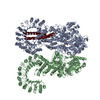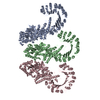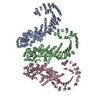+Search query
-Structure paper
| Title | Structural basis of the human NAIP/NLRC4 inflammasome assembly and pathogen sensing. |
|---|---|
| Journal, issue, pages | Nat Struct Mol Biol, Vol. 31, Issue 1, Page 82-91, Year 2024 |
| Publish date | Jan 4, 2024 |
 Authors Authors | Rosalie E Matico / Xiaodi Yu / Robyn Miller / Sandeep Somani / M Daniel Ricketts / Nikit Kumar / Ruth A Steele / Quintus Medley / Scott Berger / Benjamin Faustin / Sujata Sharma /  |
| PubMed Abstract | The NLR family caspase activation and recruitment domain-containing 4 (NLRC4) inflammasome is a critical cytosolic innate immune machine formed upon the direct sensing of bacterial infection and in ...The NLR family caspase activation and recruitment domain-containing 4 (NLRC4) inflammasome is a critical cytosolic innate immune machine formed upon the direct sensing of bacterial infection and in response to cell stress during sterile chronic inflammation. Despite its major role in instigating the subsequent host immune response, a more complete understanding of the molecular events in the formation of the NLRC4 inflammasome in humans is lacking. Here we identify Bacillus thailandensis type III secretion system needle protein (Needle) as a potent trigger of the human NLR family apoptosis inhibitory protein (NAIP)/NLRC4 inflammasome complex formation and determine its structural features by cryogenic electron microscopy. We also provide a detailed understanding of how type III secretion system pathogen components are sensed by human NAIP to form a cascade of NLRC4 protomer through a critical lasso-like motif, a 'lock-key' activation model and large structural rearrangement, ultimately forming the full human NLRC4 inflammasome. These results shed light on key regulatory mechanisms specific to the NLRC4 inflammasome assembly, and the innate immune modalities of pathogen sensing in humans. |
 External links External links |  Nat Struct Mol Biol / Nat Struct Mol Biol /  PubMed:38177670 / PubMed:38177670 /  PubMed Central PubMed Central |
| Methods | EM (single particle) |
| Resolution | 3.6 - 4.46 Å |
| Structure data | EMDB-29493, PDB-8fvu: EMDB-29496, PDB-8fw2: EMDB-29498, PDB-8fw9: |
| Chemicals |  ChemComp-ATP:  ChemComp-ZN: |
| Source |
|
 Keywords Keywords |  IMMUNE SYSTEM / IMMUNE SYSTEM /  NLRC4 / NAIP / NLRC4 / NAIP /  Inflammasome Inflammasome |
 Movie
Movie Controller
Controller Structure viewers
Structure viewers About Yorodumi Papers
About Yorodumi Papers











